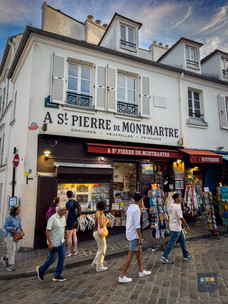Montmartre, The Village on the Hill
- Trip And Zip

- Jul 27
- 2 min read
Updated: Aug 18
There’s something magical about Montmartre—a Parisian hilltop that still feels like a village.
Once a rural village outside the city, Montmartre became a haven for artists, writers, and dreamers in the late 19th and early 20th centuries.
Names like Picasso, Toulouse-Lautrec, Renoir, Modigliani and Apollinaire all found inspiration here in smoky cafés and lively cabarets. That creative soul is still alive today, especially in the Place du Tertre, where painters set up their easels, splashing the square with color. The village spirit, with its cobbled lanes, flowered balconies, and small squares, still lingers today.
At the very top, the dazzling white domes of the Sacré-Cœur Basilica rise above the city. Built after the Franco-Prussian War of 1870–1871, the basilica was meant as a symbol of hope and reconciliation, and today it’s one of Paris’ most visited landmarks.

Reaching the top is an experience in itself, whether by climbing the famous stairs or taking the funicular, the panoramic view is unforgettable and the street musicians and performers make the journey lively.
The charm of Montmartre isn’t only in its monuments but in its atmosphere. Place du Tertre still bursts with easels and canvases, where artists paint portraits and cityscapes, carrying forward the traditions of their famous predecessors.
Small cafés and bistros, many with roots stretching back a century or more, line the cobbled lanes, offering quick meals, good wine, and a taste of neighborhood life.
Fun fact: according to legend, the word “bistro” was invented right here. Impatient customers in Montmartre cafés are said to have demanded quick service by shouting “bistrot, bistrot!” — meaning “hurry up!” The word stuck, and today it defines the very essence of Parisian casual dining worldwide.
Montmartre has managed to preserve the feeling of a village. Vine-covered houses lean into narrow streets, quirky stairways seem to pop up everywhere, and even the Musée de Montmartre, tucked away in an old artists’ residence, whispers of the area’s creative past.
For us, no visit is complete without a stop at Chez Eugène, right on the lively Place du Tertre. Sitting there, surrounded by music, chatter, and the splash of colors from painters’ canvases, feels like stepping into both history and celebration at once.

Montmartre may be crowded, but it never loses its magic. It remains a mix of history, art, food, and atmosphere: a timeless hilltop village wrapped in the soul of Paris.




























Comments